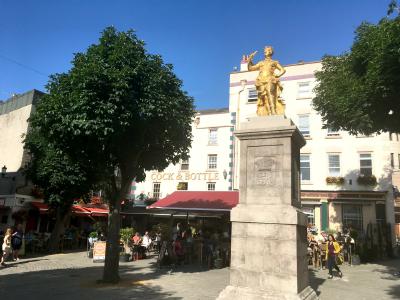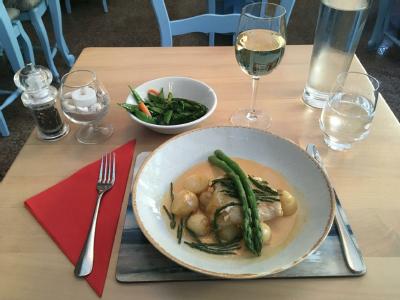
A Celtic cross and emerald green pastures
|
Ireland − 19 June 2018
If someone were to give me a house − not likely, but bear with me on this − the first thing I'd do would be to see what I'd been given.
I'd look everywhere, upstairs in the attic and downstairs in the basement.
I'd open every cabinet and closet.
I'd explore the garden, smelling the flowers and sampling the fruits and veggies.
I might even climb a tree.
I wouldn't be satisfied or feel at home until I'd seen the whole thing.
I feel the same way about our big, beautiful planet.
I'm impressed − even flabbergasted (I like that word) −
by the beauty, variety and complexity of what's here.
And I'm not done exploring Planet Earth yet.
Not by a long shot.
From Iceland, WOW Air flew me to Dublin for a bargain price of $89.
At the Dublin airport, I rented a car and spent a week driving around this beautiful and historic Emerald Isle.
The first thing I noticed is that Ireland is half as expensive as Iceland.
Yay!
Then, after I got used to driving on the wrong (left) side of the road,
I personally verified that the country is full of friendly people and lively pubs.
|

Kilkenny Castle, built in 1195
|
Ireland has many castles.
Some are ruins perched on windy hilltops and wreathed by wildflowers.
A few are like the one in Kilkenny,
inhabited for centuries and restored to almost original condition.
|
I spent two hours on my self-guided tour of the Kilkenny castle.
The Long Gallery located in the East Wing of Kilkenny Castle, was built primarily to house the Butler family's fine collection of paintings.
Nice!
If someone were to give me this castle (thank you very much)
it would take at least a week to visit every room, staircase, tower and dungeon.
And don't forget the 50 acres of terraced gardens!

Kilkenny was my first night in Ireland, and my first visit to an Irish pub.
After that, I was hooked.
Irish pubs are wonderful meeting places.
From that night on, I visited an Irish pub every night that I was in Ireland.
While spending my days site-seeing,
I looked forward to tasty beer, a good meal, new friends and great music − usually accompanied by singing and dancing.
Traveling in Ireland is easy.
All the sites are accessible by car or tour bus.
As with my Iceland blog, I'm posting here only a small sample of the photos that I took.
But you can't appreciate Ireland from photos alone.
You must go there in person to hear the music, sing the songs and dance the dances.
|

The Long Gallery of Kilkenny Castle
|

A couple of lively pubs in Kilkenny
|

An evening inside a typical Irish pub
|

Rock of Cashel (aka St.Patrick's Rock)
|

Political messages and murals in Northern Ireland
|

The tasting room in the Old Bushmills Distillery
|
One of the regions that made a deep impression on me was Northern Ireland, especially the city of Derry.
This is where the English started fighting with the Irish four centuries ago.
Since then, the dominant English forces have drawn borders and passed laws to decide where people lived and worked,
separating the Catholics from the Protestants.
Like all conflicts, this is a struggle for power and money.
Today peace has come to Derry and Belfast, but you can still feel some tension.
Watching the World Cup in the pubs in Derry,
no one cheered for England.

A trip to Ireland wouldn't be complete without a visit to a distillery.
Old Bushmills Distillery was a highlight.
After a couple of drams of fine Irish whiskey, it was time to go for a ramble on the
Giant's Causeway.
For years teaching geology, I've shown pictures of this curious formation of columnar basalt to my students.
It was satisfying to finally see this place in person.
|

Columnar basalt on the Giant's Causeway
|

The ruins of Dunseverick Castle on the north coast
|

My hosts at The Rocks B&B just outside Belfast
|
As I drove scenic highways through green hills and along the spectacular coastline,
I saw darling B&B's every few miles.
Sometimes I used the internet to book a room in advance.
Sometimes I simply knocked on the door where there was a "vacancy" sign out front.
Consistently, the accommodations were wonderful.
I think the Irish invented the Bed & Breakfast.
Here are two of my favorites:
The Rocks B&B
Athlumney Manor B&B
|

A typical Irish breakfast
|

The 5200 year old Passage Tomb in Newgrange
|
Long before the Celts came to Ireland,
there were other settlers who came here for the wildlife, minerals and green pastures.
Not much is known about these early Stone Age residents or their culture −
except that they were builders.
They built huge temples and passage tombs for their deceased that have lasted into the present.
Archaelogists have shown that some of these tombs were built with astronomical alignments.
Ireland's passage tombs are 500 years older than Egypt's pyramids and 1000 years older than Stonehenge.
The most impressive of these tombs is the
Passage Tomb in Newgrange, just north of Dublin.
No one knows where Ireland's first residents went when they left,
but I know where I'm going next.
From Ireland, I've mapped out a rough itinerary from here to Berlin,
where my son is living now.
I've seen enough airports and airplanes.
So, I plan to get to Berlin via trains, buses and boats.
I'm going to book nothing more than about 24 hours in advance.
I like traveling spontaneously and close to the ground.
This should be fun.
|
|

















































































































